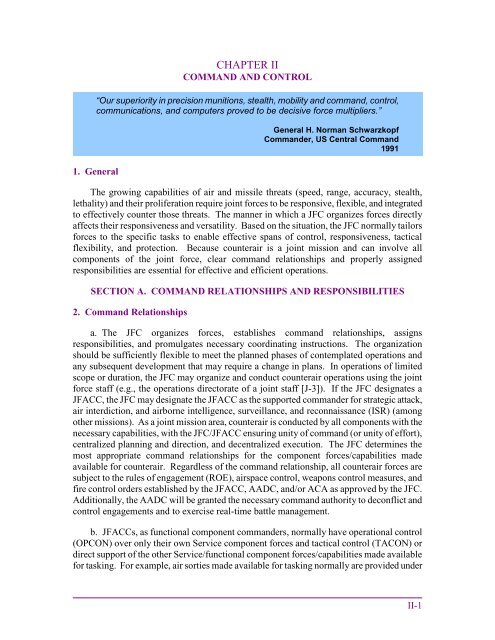JP 3-01 Countering Air and Missile Threats - Defense Innovation ...
JP 3-01 Countering Air and Missile Threats - Defense Innovation ...
JP 3-01 Countering Air and Missile Threats - Defense Innovation ...
You also want an ePaper? Increase the reach of your titles
YUMPU automatically turns print PDFs into web optimized ePapers that Google loves.
CHAPTER II<br />
COMMAND AND CONTROL<br />
“Our superiority in precision munitions, stealth, mobility <strong>and</strong> comm<strong>and</strong>, control,<br />
communications, <strong>and</strong> computers proved to be decisive force multipliers.”<br />
1. General<br />
The growing capabilities of air <strong>and</strong> missile threats (speed, range, accuracy, stealth,<br />
lethality) <strong>and</strong> their proliferation require joint forces to be responsive, flexible, <strong>and</strong> integrated<br />
to effectively counter those threats. The manner in which a JFC organizes forces directly<br />
affects their responsiveness <strong>and</strong> versatility. Based on the situation, the JFC normally tailors<br />
forces to the specific tasks to enable effective spans of control, responsiveness, tactical<br />
flexibility, <strong>and</strong> protection. Because counterair is a joint mission <strong>and</strong> can involve all<br />
components of the joint force, clear comm<strong>and</strong> relationships <strong>and</strong> properly assigned<br />
responsibilities are essential for effective <strong>and</strong> efficient operations.<br />
SECTION A. COMMAND RELATIONSHIPS AND RESPONSIBILITIES<br />
2. Comm<strong>and</strong> Relationships<br />
General H. Norman Schwarzkopf<br />
Comm<strong>and</strong>er, US Central Comm<strong>and</strong><br />
1991<br />
a. The JFC organizes forces, establishes comm<strong>and</strong> relationships, assigns<br />
responsibilities, <strong>and</strong> promulgates necessary coordinating instructions. The organization<br />
should be sufficiently flexible to meet the planned phases of contemplated operations <strong>and</strong><br />
any subsequent development that may require a change in plans. In operations of limited<br />
scope or duration, the JFC may organize <strong>and</strong> conduct counterair operations using the joint<br />
force staff (e.g., the operations directorate of a joint staff [J-3]). If the JFC designates a<br />
JFACC, the JFC may designate the JFACC as the supported comm<strong>and</strong>er for strategic attack,<br />
air interdiction, <strong>and</strong> airborne intelligence, surveillance, <strong>and</strong> reconnaissance (ISR) (among<br />
other missions). As a joint mission area, counterair is conducted by all components with the<br />
necessary capabilities, with the JFC/JFACC ensuring unity of comm<strong>and</strong> (or unity of effort),<br />
centralized planning <strong>and</strong> direction, <strong>and</strong> decentralized execution. The JFC determines the<br />
most appropriate comm<strong>and</strong> relationships for the component forces/capabilities made<br />
available for counterair. Regardless of the comm<strong>and</strong> relationship, all counterair forces are<br />
subject to the rules of engagement (ROE), airspace control, weapons control measures, <strong>and</strong><br />
fire control orders established by the JFACC, AADC, <strong>and</strong>/or ACA as approved by the JFC.<br />
Additionally, the AADC will be granted the necessary comm<strong>and</strong> authority to deconflict <strong>and</strong><br />
control engagements <strong>and</strong> to exercise real-time battle management.<br />
b. JFACCs, as functional component comm<strong>and</strong>ers, normally have operational control<br />
(OPCON) over only their own Service component forces <strong>and</strong> tactical control (TACON) or<br />
direct support of the other Service/functional component forces/capabilities made available<br />
for tasking. For example, air sorties made available for tasking normally are provided under<br />
II-1

















